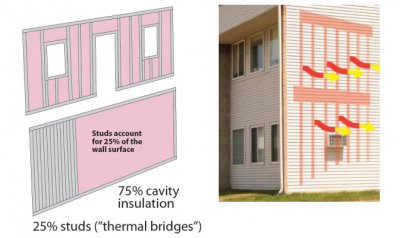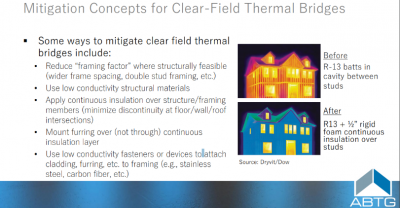Continuous insulation is a very efficient way to deal with thermal bridging pain. Why? Because a traditional R25 wall does not equal R20+5ci. The reason for this is a concept called thermal bridging, which is not dealt with well in the energy code, but plays a very important role in actual energy efficiency outcomes.
The added R5ci reduces heat loss through both the wall cavity and the framing members. A cavity insulation only wall using R29 (2x8 framing) is equivalent to R20+5ci (2x6) or R13+10ci (2x4). The effect is even greater with steel framing – steel is more conductive than wood.
The following resources on the Applied Building Technology Group website provide additional insight into the thermal bridging conundrum.
-
Thermal Bridging: A brief explanation of thermal bridging and how FPIS continuous insulation can be used for better wall performance by reducing thermal bridging.
-
Fundamentals of Thermal Bridging: This presentation, adapted from a presentation given by Jay Crandell P.E. at the 2018 ASHRAE Annual Conference, covers the basics of thermal bridging in wall assembly performance. It demonstrates methods of estimating the magnitude of the effect of thermal bridges using mathematical approaches to calculating assembly performance, and explains the pros and cons of various methods.
-
Thermal Bridging in Building Thermal Envelope Assemblies: Repetitive Metal Penetrations: Thermal bridging can significantly impact whole building energy use, condensation risk, and occupant comfort. This presentation contains an overview of the various types of thermal bridges and their impacts and a discussion of repetitive metal penetrations for cladding and component attachments.
-
Repetitive Metal Penetrations in Building Thermal Envelope Assemblies: The focus of this report is on uniformly distributed point thermal bridges. The main goal is to provide data to help better understand the implications and support an equitable, performance-based treatment of such thermal bridges for common building assembly conditions and variations.

Unfortunately, thermal bridging has generally been ignored and unregulated, except as these bridges occur due to framing members within assemblies, as shown in the graphic at right. The current prescriptive R value for an opaque wall does account for the reduced R value of the studs in a general way. Unaccounted for thermal bridging can account for 20-70% of heat flow through the building’s envelope. Reasonable efforts to use improved details to mitigate point and linear thermal bridges can significantly improve building envelope performance. For buildings with significant types or quantities of thermal bridges, it is generally more beneficial to mitigate thermal bridges than to increase insulation amounts.
Continuous insulation is one of the more efficient and effective ways to deal with thermal bridging pain and improve a building’s comfort and reduce energy use.
